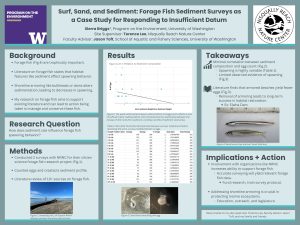Surf, Sand, and Sediment: Forage Fish Sediment Surveys as a Case Study for Responding to Insufficient Datum
Forage fish are trophically valuable but are under researched in literature surrounding marine ecosystems, thus leading to gaps in knowledge. They serve as prey to many predators, therefore supporting the greater ecosystem of the Pacific Northwest. As mentioned, the lack of literature on forage fish makes it difficult to conserve and manage them. Seeing as they are so important, the management of forage fish should be prioritized in order to protect marine ecosystems. Through collecting and analyzing sediment samples with the Nisqually Reach Nature Center in search of forage fish eggs, I sought to corroborate the claims that forage fish do have habitat preferences by analyzing the sedimentation of Dupont Wharf in Olympia, a historic spawning beach. Thus, I asked the following: How does sediment size influence forage fish spawning behavior? Given that my internship experience was constrained to one site, I sought to answer this question within the geographic limitations of Dupont Wharf. As I conducted my analysis of my results, I found that there was not a clear nor direct correlation between sediment grain size ratio and egg count, therefore re-emphasizing the importance of thorough project planning and data collection. In the absence of observable results, though, existing forage fish literature served to state the results I should have found as well as what the future trajectory of Dupont Wharf might look like in regards to spawning and sedimentation.
